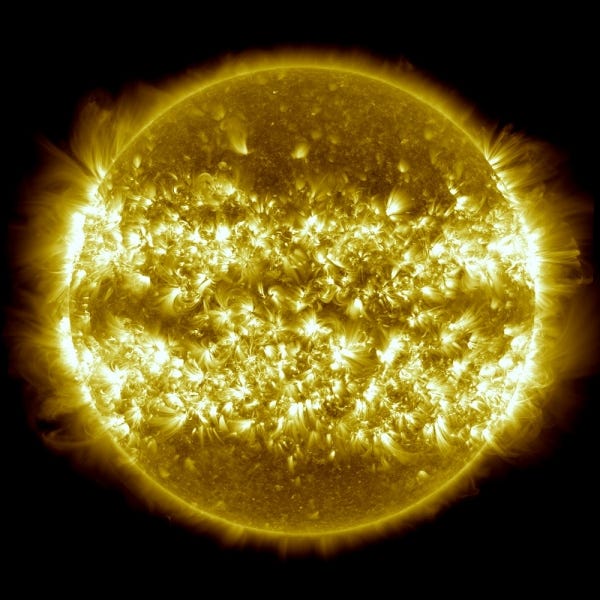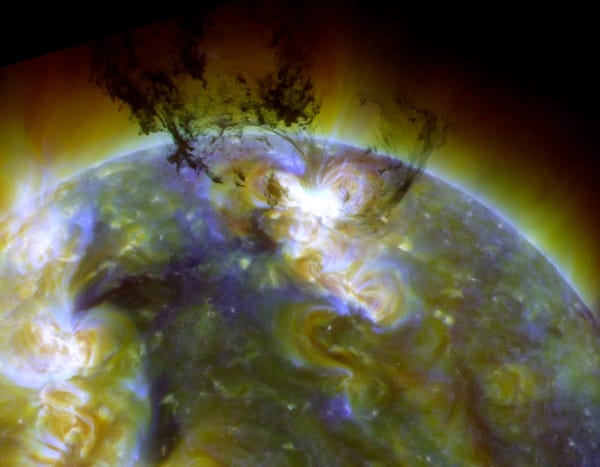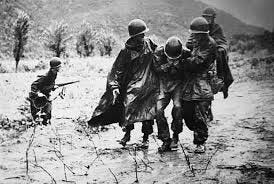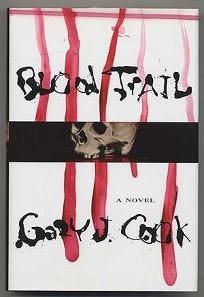
It was fascinating to learn that the sun has seasons. Earth seasons come from the tipping of the planetary axis plus close/far variations in the orbit around the sun. The sun’s seasons are more about internal relationships, not that they don’t affect us. Around here we’re aware of the eleven year cycle that is associated with rainy years and therefore with good saskatoon berry years and floods.
This is the first I’ve heard about the Gnevyshev Gap, “the lag between peak sunspot sightings in a year and a predictable wave of solar flares that follows.” Along the 49th parallel we can often see the jet stream hurtling across the sky and if it loses altitude, we lose shingles off our houses and limbs off our trees. This winter we learned about arctic oscillation and the polar vortex. The vortex is the area of coldest and fastest air on the planet. The jet stream is the outer edge of the vortex. It interacts with air pressure, temperature, and so on by moving north and south.
In terms of the sun, the bands of movement are due to bands of magnetism that pull the surface towards the center, then eject material so forcefully that it shoots into space and showers the earth with ions. To my mind such interwoven and cyclical patterns of energy are much more important to human life — as individuals and as societies — than any concept of “god.”

As I age, I sometimes have to stop and re-allocate my energy, looking at the magnetic bands and arctic vortexes. Scientific research is also morphing, not just adding facts but completely changing the concepts we thought were permanent. I like to think I’m aware and in tune with all this, but I’m probably not, and one of the abiding factors is knowing that my knowledge is incomplete.
My days are roughly in thirds: mornings are when I write (partly because in afternoon my brain energy runs low and I make a lot of typing and spelling mistakes), afternoons are when I move around doing maintenance and errands, and evenings are just random intakes: movies and books. My nights are also in thirds: sleep — writing for an hour or so before daylight — more sleep. I try to keep food, coffee and pills in sync with 6am brkfst-12 lunch-6pm supper. Hermits have to watch this sort of structure or one ends up just wasting time when the reason for being a hermit is NOT to waste time. The cats help. They believe in schedules and no matter how lost in ideas I get, they come to bump my rear as a reminder to me. They’ve learned not to meow (mostly) because I shout at them.

I’ve been in Valier, writing, for sixteen years now. Incredibly, publishing has so transformed that it probably needs a new name. On the one hand it has shattered into its parts: discovery, acquisition, production, promotion, delivery. Parts have disappeared, like reviews. Libraries are off-loading books no one checks out anymore but books are no longer pulped — instead they are recorded by vendors for resale, making available eternally what used to be on the market for about six weeks. With the help of computer translations, one can decipher writing and buy books across language boundaries.

This means that regional vs. global divisions are weakening. This means that the literature categories that used to be based on that division are falling apart. When I recently began thinking about Montana literature — a category I once assumed I would join — it had dispersed into ecological and sociological categories, east of the Rockies stretching into high prairies and leaving west of the Rockies in a sort of fancy rump Montana that requires money for lattes. Academic studies that once set up these definitions have fallen afoul of the “romance of the frontier”, pulling in many who live in a virtual world. But once here, the thin population, increasingly non-readers, means the universities produce people who must leave to find jobs.
I had greatly underestimated the degree to which writers in an academic frame of mind will form communities, which in bitter moods I call “circle jerks.” They are dying in windrows just now. So, as when trying to figure out the circumstances of a conception, one counts back from the actual birth, I count back from this wave of age-related deaths. What was happening seventy or eighty years ago? I arrive at war, which generally produces both readers and writers, hurrying up to wait. Paperbacks in hip pockets — now replaced by tablet screens.

War is always meshed with industrialization. Montana writers who enjoy industrialization like to write about Butte. Those who don’t, try to stick to indigeneity (injun-eity) and the dry grasslands. Valier began as open range, went to the industrialized and irrigated wheatlands with it’s connectome of million-dollar tractors, elevators, railroads, sea-going ships and now pump-driven wheel sprays. Impossible to imagine the next step.
Strangely, when I asked Gary J. Cook to help me think of “war” books by Montana writers, we could only think of his Vietnam-based, experience-grounded “Blood Trail,” and the law enforcement follow-up, “A Murder of Wolves.” What ever happened to the guy on a panel with me who wrote war memoirs? He self-published and was very angry.

At least three social forces move against this awareness of how much Montana activity interacts with industry. One is the feminizing of the academy which has meant a shift to romance; another is the virtual technology of the computer and internet which do not lend themselves to action and land-centered sorts of stories; and the third (there may be more) is what locals used to call “granolas,” people like David Oien who is highly educated and even “spiritual” but very much involved in alternative agriculture (lentils, etc.), guardianship of the land, and worldwide networks. It’s a fascinating repeat of a kind of thinking in my grandfather’s world. Rodale. Green revolution (reconsidered). Hard to keep a granola from growing.
David Oien
Maybe the way into all this is strategy, which ties into electronic games. Maybe the youngsters who would otherwise imagine fiction are doing the same things but with avatars instead of protagonists. They’re also very much dominated by sports. “Game of Thrones,” anyone? These are rather gender-assigned, so the guys who used to struggle to write “the great American novel” have run into a disconnect that used to be bridged by agents and editors of both sexes. Maybe we’re just all pussies these days.
Tom Sheehan

I’m going to set myself some little assignments. The first is to finally read the books Tom Sheehan sent me. He has a firm grasp of a number of genres but he is personally a veteran of the Korean War, the age-group just ahead of me. I’ll see what I can learn. I’ve resisted him earlier, though I like to read his material. It just seemed irrelevant to Montana writing as I was still thinking of it.
But now Montana has stopped existing for me. When I call or email the people in the defined circles of writers and those assigned to keep track of them, I get no answers. It’s partly debris from Bob Scriver. They think they know all about him and his shenanigans. Partly that I’m so aware of the Canadians. And realizing that peripheral academics (humanities) don’t understand blogs or blogging — consider them beneath their dignity. There’s a Gnevyshev Gap.
I want to write about a character who was real when Vollman met her: a female Afghanistan soldier, traditionally validated, entirely private, and not about sex. A crack shot, a sniper — not a truck driver. A person of landscape, self-determined. She slept a little ways from the main camp, but was very much part of it. I like that. Maybe I’ll make her a Blackfeet or Metis. I want there to be guns — not machines, but mechanisms.
Winchester .66, sometimes called "Golden Boy."


No comments:
Post a Comment